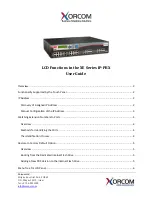
SATURN
EPABX
Installation Test Procedures
Issue May 1986
6 . 0 1
General.
After satisfactorily loading
disk
and inputting CMU data to system memory via a service ter-
minal, the operational capability of the system must be veri-
fied after the necessary MDF cross-connections are
performed. The SATURN
System software contains a
group of system and apparatus (ancillary equipment) diag-
nostic test routines which are accessed via the maintenance
phone. Resulting visual and/or audible responses from these
on-line diagnostic
tests
make it possible to verify correct oper-
ation or
detect
and isolate system and apparatus malfunc-
tions. If in doubt about a SATURN PCB or apparatus
craft personnel should refer to the SATURN
EPABX Mainionance and Troubleshooting
for fur-
ther details. If a SATURN PCB or apparatus is proven to be
defective,
craft personnel should proceed according to the
instructions contained in the MRA kit.
6.02
of Maintenance
and Modem.
Figures 6.00 and 6.01 provide the details for the maintenance
phone and modem initial MDF cross-connections. Figure 6.00
also identifies the leads used when interfacing other main-
tenance related equipment such as a power failure transfer
subsystem and dry contact closures for remote minor and
major alarm indications. Note that such equipment is
customer-provided and craft personnel should follow the
manufacturer’s instructions when installing them. To connect
maintenance phone and modem, the initial MDF
connections
as follows:
a .
Maintenance Phone. At the MDF connecting block on
which PSU cable J13 is terminated, cross-connect the
T&R leads of pair number 1
to the T&R
leads of the subscriber line circuit assigned for main-
tenance purposes (refer to Figure 6.00 for details). Note
that this subscriber line circuit must be classmarked
with the Maintenance Diagnostic Test
and
Apparatus Test (TSTAPP) features.
b .
Modem. From the system T&R connecting block that
allocates system MDF cable J44 from the basic shelf,
cross-connect the T&R of pair number 24
to the T&R leads of the subscriber line circuit to be used
for modem application (refer to Figure 6.01 for details).
The subscriber line circuit to be used for modem ap-
plication must be assigned to a class of service in
which the Data Line Security (DATASEC) classmark has
been enabled.
A f t e r t h e a b o v e i n i t i a l M D F c r o s s - c o n n e c t i o n s h a v e b e e n
performed, the DTMF telephone set to be used as the
maintenance phone can be connected to the modular
jack designated MTCE PHONE on the PSU if equipped
with a standard modular plug, or connected at the MDF
to the T&R leads of the associated subscriber line cir-
cuit. Note that if a permanent maintenance phone is
in tho equipment, it may
installed
f r o n t o f t h e c a b i n e t , a n d c r o s s - c o n n e c t e d p e r F i g u r e 6 . 0 2 .
6 . 0 3
Cross-Connecting Procedures.
After the main-
phone and modem connections have been complet-
ed, perform the necessary MDF cross-connections according
to the equipment configuration plan. The following
tions are provided to assist craft personnel in the MDF cross
connections of peripheral interfacing devices:
a .
b .
C .
d .
e .
f .
h .
i .
k.
I .
m
n .
0 .
Figures 6.02 and 6.03 Cross-Connections for rotary
or pushbutton Single Line Telephone Instruments in-
terfacing with SLMA-S and
respectively.
Figure 6.04 Cross-Connections for Siemens Digital
Telephone Interfacing with SLMD PCB.
Figure 6.05 Cross-Connections for SATURN
dant Console.
Figure 6.06
Cross-Connections for Central Office
(CO) and Direct Inward Dialing (DID) Trunks.
Figure 6.07 Cross-Connections for Two-Wire (Type
E&M Tie Trunks.
Figure 6.03 Cross-Connections for
E&M Tie Trunks.
Figure 6.09 Cross-Ccnnections for
E&M Tie Trunks.
Figure 6.10 Cross-Connections for Four Wire (Type
II) E&M Tie Trunks.
Figure 6.11
Cross-Connections for Recorded An-
nouncement Equipment (DID and Tie Trunk Vacant
Number Intercept, and ACD Announcement Service).
Figure 6.12
Cross-Connections for Coda Calling
Equipment with or without
Capability.
Figure 6.13 -Cross-Connections for DTMF Dial Dicta-
tion Equipment.
Figures 6.14 and 6.15 Cross-Connections for
on-Hold Feature via a Music Source, interfacing with
a TMBA4 and an
PCB, respectively.
Figure 6.16 Cross-Connections for Zoned Paging
Equipment With Answerback Capability.
Figure 6.17 Cross-Connections for Zoned Paging
Equipment Without Answerback Capability.
Figure 6.18 Cross-Connections for Zoned Universal
Night Answer (ZUNA or UNA) Signaling Equipment,


































